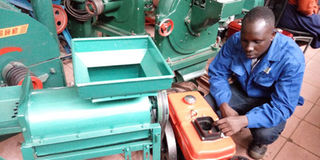Shelling maize need not be a tough task

Douglas Opio, the sales manager at China North Machine points where you top up water to keep the engine cool. Photo by Roland D Nasasira
What you need to know:
- With the harvest season upon us, a sheller will help you save time and high costs that come with using hands, writes Roland D Nasasira.
- According to Opio, this means that the amount of work (threshing) the machine can do in one hour is equivalent to what 10 men or women can do in a week.
The medium-sized machine made a loud cracking noise as it gobbled several maize cobs the operator, Douglas Opio, had placed in one of its compartments.
It took seconds for the petrol-run machine to separate the maize from the cobs. While the maize went into a gunny bag placed on an outlet on the left side of the machine, the cobs fell out on the ground in hundreds.
In four minutes, the machine, known as a maize sheller or thresher, had completed processing a 100 kilogramme bag. The sheller is on display at farm tool dealers such China North Machines, China Huangpai and Musa Body in Kampala. “Several farmers employ workers or family members to shell maize with bare hands, which is a labour-intensive exercise. But here is a machine that does that work in seconds,” explains Opio.
Moisture free
Opio who works with China North Machines, an agro machinery company as a senior agronomist in-charge of farm tools, cautions that one must ensure the maize is moisture-free to use the grinder. “If the grains still have moisture, it becomes difficult to grind the cobs as it will stick onto the grinder affecting the sheller,” he advises. The speed of the grinder can be adjusted, Opio says.
Installing
The machine, according to Opio, shells a 100 kilogrammes of maize in about four minutes.
“The speed can be increased, but four minutes is a reasonable time. The shelling kit is easy to install, remove and re-attach in case of repair or when cleaning. It works with most engines,” says Opio.
According to the agronomist, five litres of petrol shells 40 to 50 100 kilogramme bags of maize. The machines go for between Shs3m and Shs4m depending on the speed and capacity. Amooti Solomon Byenkya of Kisindizi village in Masindi District has been using the sheller for the last four years. Byenkya confesses that he reduced on costs since embracing the tool. “I used to spend more than Shs250,000 paying workers who would thresh the cobs manually,” says Byenkya. “The maize sheller has been and remains a useful tool in my farm.
I encourage both small-scale and large-scale farmers to embrace it. It is portable, easy to operate and maintain, making it affordable for the small farmer,” says Byenkya.
Eliab Baryakashanga, a mixed crop farmer in Rukungiri, says adjusting farm work from threshing maize using hands to advanced farm technology of using a maize thresher has saved him more farm costs.
“When I am not on the farm, I operate the machine myself,” he says.
How it works
Like most agricultural machines, the maize thresher equally runs on diesel fuel which is the main source of energy, while water is used for cooling the engine as it runs.
“You do not have to change the cooling water. You just have to keep topping up after every 30 minutes when the engine is running,” Douglous Opio the sales manager at China North Machine advises.
In an hour, the maize thresher consumes 0.5 litres of fuel, with a total output of approximately two tonnes in the same time period.
According to Opio, this means that the amount of work (threshing) the machine can do in one hour is equivalent to what 10 men or women can do in a week.
“There are farmers who thresh their maize by hitting it. It may work but in the process, some maize is crushed and this is an uncalculated loss for the farmer. When you use the maize thresher, there is a very small percentage or no losses incurred at all,” Opio observes.




